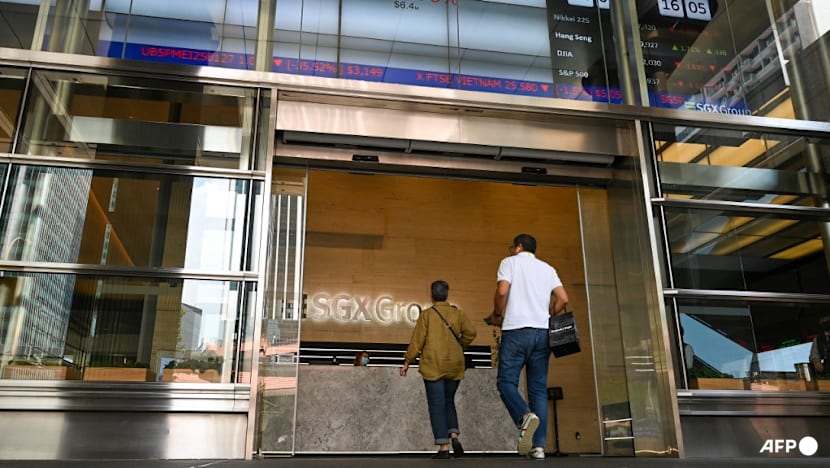Commentary: Singapore's mid-cap moment has finally arrived
The launch of two new indices tracking SGX’s next 50 largest stocks could be the long-awaited catalyst to revitalise the Singapore stock market, says former editor and financial journalist Ven Sreenivasan.

File photo of people entering the Singapore Exchange Limited (SGX) headquarters. (Photo: AFP/Roslan Rahman)

This audio is generated by an AI tool.
SINGAPORE: It's finally here. And it may be exactly what the doctor ordered to revive and revitalise the Singapore stock market.
Two new indices have arrived that (hopefully) accurately capture and reflect the growing middle tier of the local bourse: the iEdge Singapore Next 50 Index, weighted by market capitalisation, and the iEdge Singapore Next 50 Liquidity Weighted Index, weighted by turnover to reflect trading activity.
Together, these two indices capture the movements of mid-caps, which have largely been excluded from the marquee 30-stock Straits Times Index (STI). They include stocks of the next tier of large and liquid mainboard companies, beyond the market’s 30 largest companies.
The iEdge Singapore Next 50 Index was up 0.07 per cent to 1428.66 points on a somewhat quiet Monday (Sep 22), while the Liquidity Weighted was up 0.14 per cent to 1104.53. Both would be up some 23 per cent if the index were theoretically “stretched back” to March or April this year.
The launch of the two new indices comes barely weeks after National Development Minister and Monetary Authority of Singapore Deputy Chairman Chee Hong Tat revealed that a new index would be created to help investors follow how “the next tier of large and liquid companies” are evolving, be it through business model transformation, improved governance, or strengthening their capital management.
Using a rules-based methodology, the new indices apply criteria such as free-float adjustment, market capitalisation and liquidity to identify companies that are both sizable and actively traded. Criteria include a 15 per cent minimum free float, a minimum turnover of S$100,000 and a minimum market cap of S$100 million. There will be some index rebalancing at regular intervals - in March, June, September and December. This would ensure that component stocks remain relevant and meet thresholds for minimum market capitalisation and liquidity.
Many of the stocks in the indices are familiar names which I have written about in previous columns, and which the market had been expecting, including the likes of Boustead, Wee Hur, PropNex, Centurion, Sheng Siong and various S-Reits.
So what’s next?
READY FOR PRIME TIME
As the Singapore Exchange’s head of equities Ng Yao Loong put it, by showcasing companies beyond the STI’s top 30, these indices will help investors better capitalise on the full spectrum of opportunities in the Singapore stock market.
“It also serves as a starting point for market participants to explore innovative ways of tracking the performance of different segments of the Singapore market,” he added.
This is where the rubber meets the road.
The Singapore market could see more upside as investors chase up component stocks of the new iEdge Singapore indices, which essentially track the performance of the next 50 largest companies on the mainboard.
But more critically, they could enjoy even more upside if institutional investors and funds latch on to them or build passive Exchange Traded Funds or ETFs based on the new indices or portions of them.
The MAS has allocated some S$5 billion to revive the market under its Equity Market Development Programme (EQDP), with S$1 billion already allocated across three funds tasked with breathing new energy into mid-cap stocks. These funds will likely start building up portfolios based on the component stocks of the two new indices. They could also build ETFs to track them.
More money from the EQDP could be disbursed in the days ahead, with the mandate to deploy to these mid-caps and indices which track them.
COULD THE “NEXT 50” SPUR A SHIFT IN CAPITAL FLOW?
All this comes as a combination of ample liquidity and falling interest rate yields provides upside momentum for equities worldwide. Wall Street indices are already at record highs on the back of strong interest in tech and healthcare stocks.
In Singapore, despite some volatility, the STI remains elevated around the 4,300 mark.
But what is more interesting now is that beneath and beyond this marquee market index, mid-tier stocks have been chased up on optimism of significant regulatory and financial support. Going back three to six months, component stocks on the iEdge Singapore indices are up 20 to 23 per cent, compared to about 12 to 14 per cent for STI components.
The iEdge Singapore indices could add momentum to this upside.
Could this result in a shift in capital flow, with resources being directed toward emerging sectors that show promise for growth? Quite possibly. If this shift happens, it will create both opportunities and challenges for established industries, prompting them to innovate or adapt to maintain their market positions.
There is no silver bullet here. Inclusion in the index is just the beginning. Companies must play their part in proactively engaging shareholders and the investing public at large.
This means regular and active investor engagement beyond annual or half-yearly earnings briefings. Senior company officials must communicate more consistently and clearly, and make their business activities more visible to the market. Done well, this will boost and retain investor interest, spark liquidity and engage institutional investors who for so long have focused on the STI’s “big boys”.
For now, all the critical arrangements needed to reshape and provide more balance to the erstwhile moribund Singapore market are in place. The SGX has put out a homegrown index similar to its other indices like the iEdge Singapore Low Carbon Select 40 and iEdge S-Reit Leaders Index. Investors now have a new platform that highlights stocks that have outperformed the broader market, and for good reason.
But history shows that markets never go up in a straight line. Geopolitical, economic and regulatory risks abound. In the words of the late Donald Rumsfeld, there are “known knowns” and “known unknowns” investors can prepare or brace for. But there are also “unknown unknowns” that can blindside even the most seasoned among them.
Ultimately, the interplay between optimism and caution will shape the investment landscape on the SGX in the coming months. But for now, all the pieces seem to be in place, and in play.
Ven Sreenivasan is a former editor and journalist who has covered financial markets, economic and corporate news and aviation for more than 30 years.
















